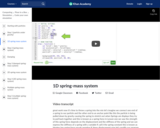
Now we attach our particle to a spring.
- Subject:
- Applied Science
- Arts and Humanities
- Computer Science
- Graphic Arts
- Material Type:
- Lesson
- Provider:
- Khan Academy
- Provider Set:
- Pixar
- Author:
- Disney Pixar
- Khan Academy
- Date Added:
- 07/14/2021

Now we attach our particle to a spring.
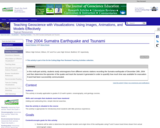
In this multi-part activity, students study seismograms from 3 different seismic stations recording the magnitude 9.0 Sumatra earthquake of December 26th, 2004. By comparing the arrival times of the P and S waves on each seismogram, students determine the distance from the epicenter to each station. Using that data, they can accurately map the location of the epicenter and the precise time of the earthquake. After locating the epicenter, students calculate the position of the tsunami generated by the quake at one hour intervals. From those determinations, predictions are made about how much time people had before the tsunami crashed onto their shores. Finally, students investigate some of the ways people can lessen the impact of the next great tsunami.
(Note: this resource was added to OER Commons as part of a batch upload of over 2,200 records. If you notice an issue with the quality of the metadata, please let us know by using the 'report' button and we will flag it for consideration.)

Presentations, materials and other resources offered throughout the 2019 Continuous Quality Improvement Statewide Conference for Child Welfare and Probation at UC Davis.
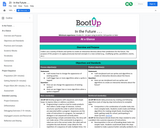
Coders use a variety of blocks and sprites to create an interactive diorama about their predictions for the future. The purpose of this project is to apply previously learned concepts in a new context (e.g., modifying sprites, parallelism, events, etc.).
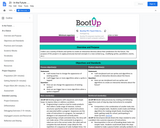
Coders use a variety of blocks and sprites to create an interactive diorama about their predictions for the future. The purpose of this project is to apply previously learned concepts in a new context (e.g., modifying sprites, parallelism, events, etc.).
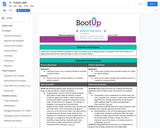
Coders use a variety of blocks in parallel to create simulations (e.g., dribbling a ball). The purpose of this short project is to apply previously learned understandings in order to simulate motion.
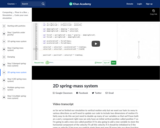
Now we add a horizontal component to our system.
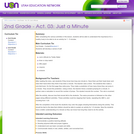
After completing the various activities in this lesson, students will be able to understand the importance for a healthy body to be able to do an activity for 1 - 5 minutes.

This resource is a video abstract of a research paper created by Research Square on behalf of its authors. It provides a synopsis that's easy to understand, and can be used to introduce the topics it covers to students, researchers, and the general public. The video's transcript is also provided in full, with a portion provided below for preview:
"When modern 3D printing was invented in the early 1980s, few could have predicted the influence it has today. At no other time in history has it been this easy to transform a sketch into the real thing. And while that feat has proven immensely useful for constructing complex machines, it is unlikely more meaningful anywhere else today than in the field of biomedicine. With the ability to churn out standard or custom prosthetics, devices, and even test models, the 3D printing of biomaterials is revolutionizing medical care. One of the greatest conveniences afforded by biomedical 3D printing is the ability to manufacture parts on demand. Common load-bearing prosthetics, such as those for knee or hip replacements, no longer have to be built in bulk and benched before use. Virtually stored print files can be called upon and processed into parts as soon as they are needed in the clinic, with the printing material and method suited to the part’s function and placement..."
The rest of the transcript, along with a link to the research itself, is available on the resource itself.
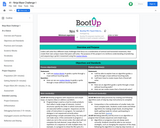
Coders will solve four different maze challenges that focus on a combination of vertical and horizontal movement, then create their own unique mazes that peers will solve. The purpose of this project is to reinforce understanding of predicting and sequencing a sprite’s movement using the motion blocks.
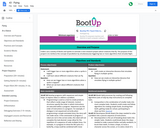
Coders use a variety of blocks and sprites to animate a mini research project about creatures that fly. The purpose of this project is to reinforce the concept of parallelism by simultaneously triggering two or more algorithms that simulate flight.
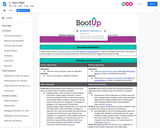
Coders learn how to use repeat forever blocks with looks and control blocks to create a simulated environment. The purpose of this project is to introduce new blocks and block combinations that are triggered with the green flag.
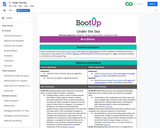
Coders review how to use repeat forever blocks with looks and control blocks to create a different simulated environment. The purpose of this project is to continue applying understanding from the previous project to trigger new blocks and block combinations with the green flag.
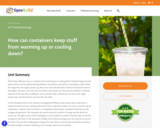
This unit on thermal energy transfer begins with students testing whether a new plastic cup sold by a store keeps a drink colder for longer than the regular plastic cup that comes free with the drink.
Through a series of lab investigations and simulations, students find two ways to transfer energy into the drink: (1) the absorption of light and (2) thermal energy from the warmer air around the drink. They are then challenged to design their own drink container that can perform as well as the store-bought container, following a set of design criteria and constraints.
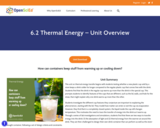
Unit Summary
This unit on thermal energy transfer begins with students testing whether a new plastic cup sold by a store keeps a drink colder for longer compared to the regular plastic cup that comes free with the drink. Students find that the drink in the regular cup warms up more than the drink in the special cup. This prompts students to identify features of the cups that are different, such as the lid, walls, and hole for the straw, that might explain why one drink warms up more than the other.
Students investigate the different cup features they conjecture are important to explaining the phenomenon, starting with the lid. They model how matter can enter or exit the cup via evaporation However, they find that in a completely closed system, the liquid inside the cup still changes temperature. This motivates the need to trace the transfer of energy into the drink as it warms up. Through a series of lab investigations and simulations, students find that there are two ways to transfer energy into the drink: (1) the absorption of light and (2) thermal energy from the warmer air around the drink. They are then challenged to design their own drink container that can perform as well as the store-bought container, following a set of design criteria and constraints.
This unit builds toward the following NGSS Performance Expectations (PEs) as described in the OpenSciEd Scope & Sequence: MS-PS1-4*, MS-PS3-3, MS-PS3-4, MS-PS3-5, MS-PS4-2*, MS-ETS1-4. The OpenSciEd units are designed for hands-on learning and therefore materials are necessary to teach the unit. These materials can be purchased as science kits or assembled using the kit material list.
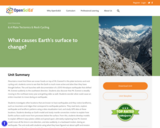
In this plate tectonics and rock cycling unit, students come to see that the Earth is much more active and alive than they have thought before. The unit launches with documentation of a 2015 Himalayan earthquake that shifted Mt. Everest suddenly to the southwest direction. Students read texts, explore earthquake and landform patterns using a data visualization tool, and study GPS data.
This unit is part of the OpenSciEd core instructional materials for middle school.

Unit Summary
In this unit, students develop ideas related to how sounds are produced, how they travel through media, and how they affect objects at a distance. Their investigations are motivated by trying to account for a perplexing anchoring phenomenon — a truck is playing loud music in a parking lot and the windows of a building across the parking lot visibly shake in response to the music.
They make observations of sound sources to revisit the K–5 idea that objects vibrate when they make sounds. They figure out that patterns of differences in those vibrations are tied to differences in characteristics of the sounds being made. They gather data on how objects vibrate when making different sounds to characterize how a vibrating object’s motion is tied to the loudness and pitch of the sounds they make. Students also conduct experiments to support the idea that sound needs matter to travel through, and they will use models and simulations to explain how sound travels through matter at the particle level.
This unit builds toward the following NGSS Performance Expectations (PEs) as described in the OpenSciEd Scope & Sequence: MS-PS4-1, MS-PS4-2. The OpenSciEd units are designed for hands-on learning and therefore materials are necessary to teach the unit. These materials can be purchased as science kits or assembled using the kit material list.
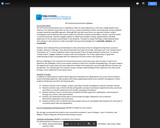
This AP Environmental Science class is intended to meet the same objectives as a first-year college-based course.
However, the method of instruction for this course is unique compared to similar courses because we have adopted
a project-based learning (PBL) approach. Although PBL may take many forms, our approach involves student
investigations and simulations that require students to think like scientists, policymakers, farmers, and other adults
in real-world settings. Teachers engage students in collaborative problem solving, argumentation, and deep
exploration of the concepts and principles of the discipline. The goal for student learning is understanding rather
than relying on rote memory to create meaningful learning and knowledge that is actionable, adaptive, and
transferable.
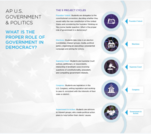
This course contains five projects that are organized around the following question: “What is the proper role of government in a democracy?” Each project involves political simulations through which students take on roles that help contextualize the content required by the new College Board course framework.
Founders' Intent
Elections
Supreme Court
Congress
Government in Action
Openly licensed PDF unit plans of all the above units are available at this Sprocket Lucas Education Research Platform (scroll to bottom of web page).
Alternately, educators may sign up for free access to the online AP U.S. Government and Politics course that includes additional instructional supports:
https://sprocket.lucasedresearch.org/users/sprocket_access
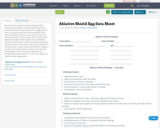
You will present students with a challenge: build a structure from different materials that will protect a model of the Ares launch vehicles (a raw egg) from the heat of a propane torch for as long as possible. Then they design, build, test, and revise their own thermal protection systems. They document their designs with sketches and written descriptions. As a culmination, students compile their results into a poster and present them to the class.
This activity explores the concepts of energy transfer with the following standards:
• Energy is a property of many substances and is associated with heat and light.
• Heat moves in predictable ways, flowing from warmer objects to cooler ones, until both reach the same temperature.